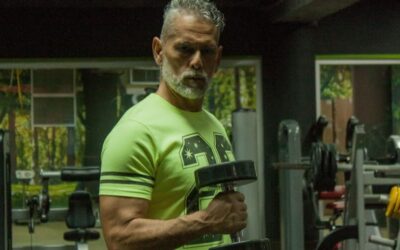The shin bone’s connected to the…neck bone? Not directly, no. But in a circuitous way, your entire body is one intricate web of parts that all affect one another in ways both obvious and discrete.
Have you ever pulled a muscle in your neck or lower back, only to experience unexpected soreness in your shoulders or hips? Maybe you’ve stubbed your toe only to wake up the next day with sore calves. Has your forehead ever hurt from smiling too much? All these things are possible because your body is interconnected.
When you increase your strength in a certain muscle group – say, the big muscles in your upper legs: quadriceps, hamstrings, adductors – that new strength will increase your ability to jump higher, carry more weight, and climb more steps. It’s not just about making your legs bigger for the sake of filling out your Levi’s. Your whole body becomes more capable of strength when you increase the performance ability of any one muscle group.
Unfortunately, the same concept holds true when you get injured. An injury to even a small, inconspicuous body part can affect your entire body in a major way. Depending on the severity, location, and nature of the injury, your doctor or physical therapist will be able to craft a therapy regimen that not only helps bring your injured body part back to life, but help you keep the rest of yourself in shape while the injury heals.
Let’s look at two specific ways an injury can affect your entire body.
Increased Risk of Strains and Sprains
You strain a muscle or tendon; you sprain a ligament. These confusingly similar terms describe the same injury: a stretch or a tear in the fibers of muscles or ligaments. You can strain or sprain your tendons or muscle fibers in a few ways: repeated movements over a period of time (running, rowing, or throwing a baseball, for example), through a forceful impact incurred during a physical sport (think football, rugby, soccer, etc.), or from a seemingly minor movement in which you twisted in just the wrong way with just enough force.
It’s bad enough for an athlete (or average person) to get a sprain or a strain, but it’s made worse if the injury is severe enough that a lengthy recovery period is necessary to heal properly. This can not only impact the rest of the physical body, but it can take a mental toll as well.
If you’ve sprained an ankle, for example, you are probably going to limp around in order to ease the pressure you put on that crucial joint. When you do that, you start to use other muscle groups in inefficient ways. When you limp, you swing your hips differently, and you may add a slight twist in your knees to compensate for your limited range of motion. Since one of the ways you can get a sprain or strain is repeated movements over a period of time, you could be setting yourself up for more muscle, tendon, or ligament injuries simply by trying to manage that first injury.
Weakness During Certain Motions
Let’s take one major muscle group that we all use for nearly every movement we’ll ever make: the shoulder. We use our shoulders in major ways – any lifting, pushing, or pulling movement we make – as well as minor ways that we aren’t actively aware of. For example, when you are walking through a crowd, you are likely turning your torso and pointing your shoulders so that you can more easily slip through the throng. Picture a child trying to walk along a raised curb or balance beam at the park with their arms out to the sides to provide balance. That child may also be wearing a backpack, his or her shoulders bearing the weight in tandem with the torso.
When you strain a muscle in a joint like your shoulder – an omnidirectional joint that your body relies on for involuntary balance as well as daily feats of strength – you might not even realize it right away. You may feel pain and tightness whenever you initiate a pulling movement (like lifting your work bag all day long) and feel no pain whenever you initiate a pushing movement (like opening a door). Still, you may realize that your push movement starts to lose power – or you get that feeling like you’ve hit a dead spot and your arm just falls to the side – because of the injury that happened to the muscles responsible for your pull action. But since those muscle fibers are torn, inflamed, swollen, and filled with responding blood cells, that will impact nearby healthy fibers by essentially pushing them out of the way and putting extra strain on them.
Healing the Shin to Fix the Neck
So what happens when you strain a shoulder muscle, or feel significant pain in this complex joint? You may have absolutely no problems with one specific movement, but then suddenly you’re lifting your arm above your head to put on a shirt and you feel a zap of pain and hit a ‘dead spot’ that forces your arm to drop to your sides. Now what? Your physical therapist can help identify the injury and help you strike the balance between rest and exercise.
Take this thought from a text published in the Muscle, Ligaments and Tendons Journal in 2014: “…it should be noted that the duration of reduced activity (immobilization) ought to be limited only until the scar reaches sufficient strength to bear the muscle-contraction induced pulling forces without re-rupture. At this point, gradual mobilization should be started followed by a progressively intensified exercise program to optimize the healing by restoring the strength of the injured muscle, preventing the muscle atrophy, the loss of strength and the extensibility, all of which can follow prolonged immobilization.”
This effectively suggests that when you sprain or strain something, your recovery should begin at the point where your body has had enough rest to heal the injury, but before the development of scar tissue begins to immobilize the fibers that were injured and limit the usefulness of the muscle or ligament into the future. You should take it slow and gradually introduce more weight, more reps, more miles, etc. depending on your method of recovery.
Talk to your physical therapist to determine the best course of action to meet your goals based on the nature and severity of your injury.
Relevant Sources for How Injuries Affect Your Entire Body:
![woman-back-spine[1] image of woman's back](https://www.risephysicaltherapy.com/wp-content/uploads/2023/04/woman-back-spine1.jpg)

